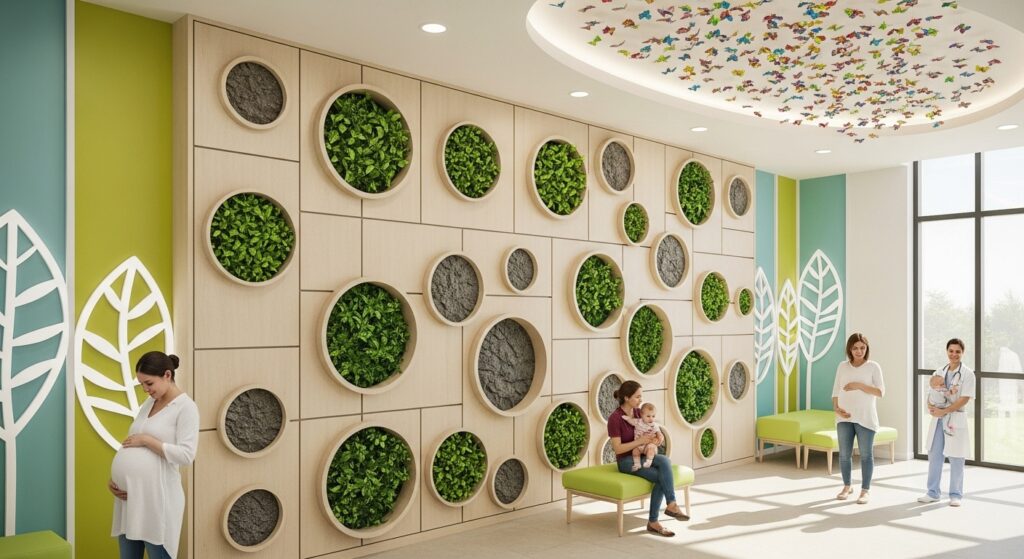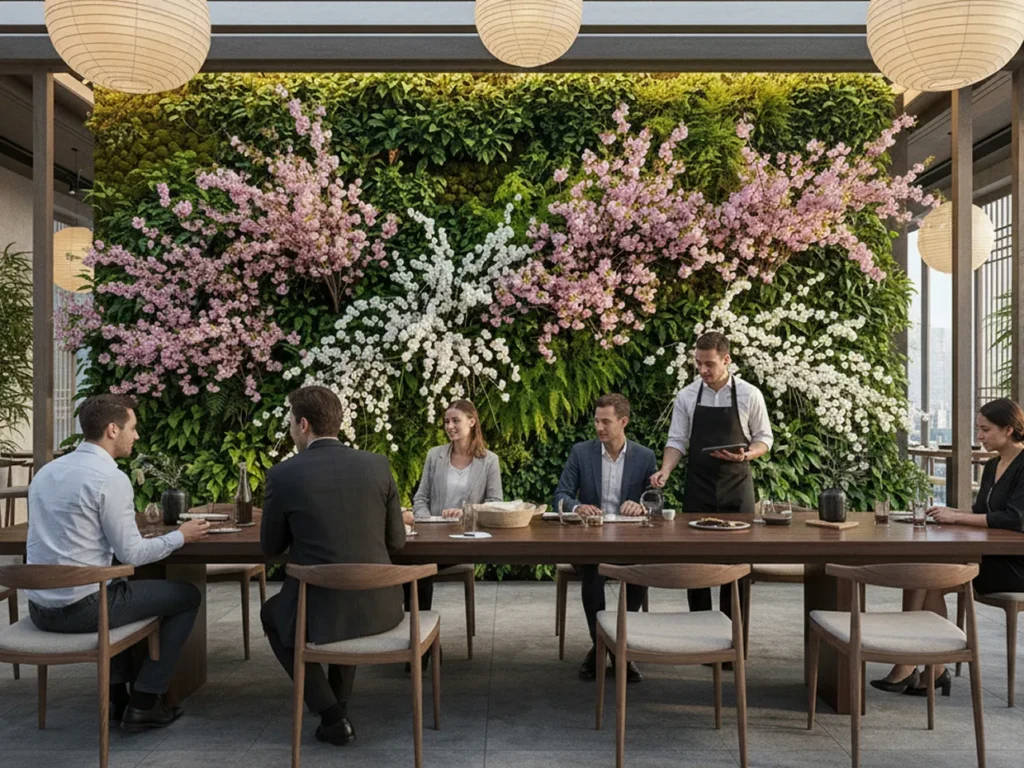

How do modular and non-modular green walls differ structurally?
Both systems bring biophilic design to architectural environments, but their construction logic is fundamentally different.
| Feature | Modular System | Non-Modular System |
|---|---|---|
| Structure | Factory-fabricated panels or trays (often 12–24 in²) containing their own substrate, irrigation dripline, and drainage layer. | Continuous wall-mounted framework filled with shared soil or hydroponic media applied on-site. |
| Installation | Dry, fast, and reversible—modules lock into aluminum rails or z-clips. | Wet and permanent—requires waterproofing, framing, irrigation, and drainage integrated in layers. |
| Maintenance | Individual modules can be swapped or serviced. | Sectional repair is difficult once the wall is complete. |
| Weight & Load | Lightweight composite panels (PET, HDPE, or aluminum). | Heavier because of continuous media and retained water. |
Modular systems behave like a kit-of-parts facade, while non-modular designs are more like living masonry—crafted, continuous, and organic but less predictable.
How does plant ecology differ between modular and non-modular systems
Modular Systems: Controlled Micro-Environments
Each cell or tray forms its own micro-ecological chamber. Roots are isolated by physical walls, so:
- Plants do not compete for root space or nutrients.
- Watering and fertilization can be tuned to each module’s needs.
- Root-zone oxygenation remains balanced, preventing anaerobic rot.
- Mortality rates drop by 25–40 % over the first three years compared to continuous beds.
This “root zoning” also reduces the need for replanting cycles—vital in corporate or hospitality interiors where downtime is costly.
Non-Modular Systems: Shared Root Ecosystem
Non-modular walls use a continuous substrate or hydroponic felt sheet, allowing roots to wander. While this produces a seamless, natural aesthetic, it comes with trade-offs:
- Dominant species out-compete weaker ones for nutrients and moisture.
- Root tangling increases mechanical stress and can clog irrigation lines.
- Over time, denser root mats push against the backing membrane, demanding structural inspection.
To control this, horticultural designers often specify root barriers or zoning grids, but these add installation complexity.
What irrigation and drainage strategies support each system?
| Aspect | Modular | Non-Modular |
|---|---|---|
| Water Delivery | Each module contains micro-drip emitters or capillary mats fed by horizontal manifolds. | Continuous drip tubing or hydroponic film across the wall. Balancing pressure is critical. |
| Drainage | Built-in rear channels direct excess water to collection trays. | Continuous drainage mat and bottom trough connected to a plumbed outlet. |
| Control | Easily automated by zone; allows differential watering. | One large irrigation loop; uniform delivery can lead to localized oversaturation. |
| Plant Health Impact | Even hydration, no nutrient drift between modules. | Risk of uneven wet/dry pockets and algae buildup if flow isn’t perfectly tuned. |
For living greenery, modular irrigation ensures consistent moisture and eliminates root competition, directly improving longevity. Non-modular systems excel when a lush, naturally blended look is prioritized and full-time horticultural maintenance is available.
How do attachment systems influence design flexibility?
Modular Systems
- Use extruded-aluminum rail or grid frameworks anchored to standard studs or concrete.
- Panels slide or hook into place.
- Average installation time: Faster than custom continuous builds.
- Suited for retrofits, tenant improvements, and acoustic integrations.
Non-Modular Systems
- Require heavy-duty sub-framing with waterproof membranes, often coordinated with mechanical and plumbing trades.
- Because they are “site-grown,” removal or relocation is rarely feasible.
- Common in atriums, exterior facades, or feature lobbies where permanence outweighs serviceability.

Lamina, Preserved Moss Walls Design by CSI Creative
How does acoustic and thermal performance compare?
- Modular acoustic greenery systems can incorporate felt or PET substrates (NRC ≈ 0.80–0.90). The foliage traps and diffuses sound waves, while the felt layer absorbs reverberation—creating bio-acoustic synergy.
- Non-modular living walls have also good acoustic absorption if backed by porous felt or mineral wool. Their moisture-laden media actually transmit low frequencies more efficiently.
Thermally, modular panels create a small ventilated cavity behind the wall, enhancing insulation. Non-modular walls add thermal mass but can increase humidity if poorly ventilated.
What is the CSI Creative offering in modular green wall systems?
CSI Creative’s green walls exemplifie advanced modular design—combining acoustics, biophilia, and fire safety in a single prefabricated system.
Technical Highlights
- Soundcore® PET felt backing (ASTM E84 Class A, high NRC).
- ThermaLeaf® replica greenery—flame-retardant at the polymer level.
- Options for preserved or live plant inserts with capillary or drip irrigation.
- Lightweight aluminum rail attachment, pre-assembled for rapid on-site install.
- Fully compliant with Division 09 specification for interior wall and ceiling integration.
Design Freedom
Choose from Trimmed, Lush, or Mixed tiers to control visual density and texture, or request custom patterns aligned with brand identity. Panels can transition from wall to ceiling for immersive biophilic envelopes.
Why CSI Creative
- Single point of contact from design to delivery.
- WELL Building, HPD, and Declare certifications, plus 2024 and 2025 Architizer A+ Product Awards recognitions.
CSI Creative’s modular approach ensures plants thrive individually, acoustics perform collectively, and installation proceeds architecturally—fast, precise, and sustainable.

Mandara, Artificial Green Walls Design by CSI Creative
Final Thoughts
When root health, acoustic control, and serviceability drive the specification, modular green wall systems offer unmatched reliability and performance.
For sculptural, one-off biophilic statements with a living ecosystem feel, non-modular walls remain the artisan’s choice—but they demand continuous horticultural management.







